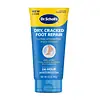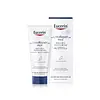What's inside
What's inside
 Key Ingredients
Key Ingredients

 Benefits
Benefits

 Concerns
Concerns

 Ingredients Side-by-side
Ingredients Side-by-side

Water
Skin ConditioningUrea
BufferingBeeswax
Emulsion StabilisingCaprylic/Capric Triglyceride
MaskingLanolin
EmollientCetyl Alcohol
EmollientGlyceryl Stearate
EmollientMalic Acid
BufferingPEG-100 Stearate
Lactic Acid
BufferingSodium Hydroxide
BufferingMagnesium Sulfate
Phenoxyethanol
PreservativeSilk Amino Acids
HumectantTocopheryl Acetate
AntioxidantParfum
MaskingAllantoin
Skin ConditioningDisodium EDTA
Ethylhexylglycerin
Skin ConditioningMentha Piperita Oil
MaskingLavandula Angustifolia Oil
MaskingMentha Arvensis Leaf Oil
MaskingMentha Spicata Herb Oil
PerfumingEucalyptus Globulus Leaf Oil
PerfumingWater, Urea, Beeswax, Caprylic/Capric Triglyceride, Lanolin, Cetyl Alcohol, Glyceryl Stearate, Malic Acid, PEG-100 Stearate, Lactic Acid, Sodium Hydroxide, Magnesium Sulfate, Phenoxyethanol, Silk Amino Acids, Tocopheryl Acetate, Parfum, Allantoin, Disodium EDTA, Ethylhexylglycerin, Mentha Piperita Oil, Lavandula Angustifolia Oil, Mentha Arvensis Leaf Oil, Mentha Spicata Herb Oil, Eucalyptus Globulus Leaf Oil
Water
Skin ConditioningUrea
BufferingGlycerin
HumectantCetearyl Alcohol
EmollientCaprylic/Capric Triglyceride
MaskingGlyceryl Stearate
EmollientEthylhexyl Cocoate
EmollientHydrogenated Coco-Glycerides
EmollientOctyldodecanol
EmollientSodium Lactate
BufferingGlyceryl Stearate Se
EmulsifyingDistarch Phosphate
AbsorbentCeramide NP
Skin ConditioningLactic Acid
BufferingArginine Hcl
Skin ConditioningSodium PCA
HumectantCholesterol
EmollientHelianthus Annuus Seed Oil
EmollientAlanine
MaskingCarnitine
CleansingGlycine
BufferingSodium Chloride
MaskingDimethicone
EmollientCarbomer
Emulsion StabilisingSorbitan Stearate
EmulsifyingSodium Cetearyl Sulfate
CleansingPhenoxyethanol
PreservativeWater, Urea, Glycerin, Cetearyl Alcohol, Caprylic/Capric Triglyceride, Glyceryl Stearate, Ethylhexyl Cocoate, Hydrogenated Coco-Glycerides, Octyldodecanol, Sodium Lactate, Glyceryl Stearate Se, Distarch Phosphate, Ceramide NP, Lactic Acid, Arginine Hcl, Sodium PCA, Cholesterol, Helianthus Annuus Seed Oil, Alanine, Carnitine, Glycine, Sodium Chloride, Dimethicone, Carbomer, Sorbitan Stearate, Sodium Cetearyl Sulfate, Phenoxyethanol
 Reviews
Reviews

Ingredients Explained
These ingredients are found in both products.
Ingredients higher up in an ingredient list are typically present in a larger amount.
This ingredient is an emollient, solvent, and texture enhancer. It is considered a skin-softener by helping the skin prevent moisture loss.
It helps thicken a product's formula and makes it easier to spread by dissolving clumping compounds.
Caprylic Triglyceride is made by combining glycerin with coconut oil, forming a clear liquid.
While there is an assumption Caprylic Triglyceride can clog pores due to it being derived from coconut oil, there is no research supporting this.
Learn more about Caprylic/Capric TriglycerideGlyceryl Stearate is a mix of glycerin and stearic acid.
It is used to stabilize the mixing of water and oil ingredients. By preventing these ingredients from separating, it can help elongate shelf life. It can also help thicken the product's texture.
As an emollient, it helps soften skin and supports barrier-replenishing ingredients.
In cosmetics, Glyceryl Stearate is often made from vegetable oils or synthetically produced.
This ingredient may not be fungal-acne safe
Fun fact: The human body also creates Glyceryl Stearate naturally.
Learn more about Glyceryl StearateLactic Acid is another well-loved alpha hydroxy acid (AHA). It is gentler than glycolic acid but still highly effective.
Its main role is to exfoliate the surface of the skin by loosening the “glue” that holds dead skin cells together. Shedding those old cells leads to smoother, softer, and more even-toned skin.
Because lactic acid molecules are larger than glycolic acid, they don’t penetrate as deeply. This means they’re less likely to sting or irritate, making it a great choice for beginners or those with sensitive skin.
Like glycolic acid, it can:
Lactic acid also acts as a humectant (like hyaluronic acid). It can draw water into the skin to improve hydration and also plays a role in the skin's natural moisturizing factor (NMF) in the form of sodium lactate.
Studies show it can boost ceramide production to strengthen the skin barrier and even help balance the skin’s microbiome.
To get results, choose products with a pH between 3-4.
Lower strengths (5-12%) focus on surface exfoliation; higher strengths (12% and up) can reach deeper in the dermis (deeper, supportive layer) to improve skin texture and firmness over time.
Though it was originally derived from milk, most modern lactic acid used in skincare is vegan. It is made through non-dairy fermentation to create a bio-identical and stable form suitable for all formulations.
When lactic acid shows up near the end of an ingredient list, it usually means the brand added just a tiny amount to adjust the product’s pH.
Legend has it that Cleopatra used to bathe in sour milk to help reduce wrinkles.
Lactic acid is truly a gentle multitasker: it exfoliates, hydrates, strengthens, and brightens. It's a great ingredient for giving your skin a smooth, glowing, and healthy look without the harshness of stronger acids.
Read more about some other popular AHA's here:
Learn more about Lactic AcidPhenoxyethanol is a preservative that has germicide, antimicrobial, and aromatic properties. Studies show that phenoxyethanol can prevent microbial growth. By itself, it has a scent that is similar to that of a rose.
It's often used in formulations along with Caprylyl Glycol to preserve the shelf life of products.
Urea is also called carbamide and is the diamide of carbonic acid. In cosmetics, urea is used to hydrate the skin. It also provides exfoliation in higher concentrations.
As a humectant, urea helps draw moisture from the air and from deep within the skin. This helps hydrate your skin. Studies show urea is an effective moisturizer for dry skin conditions. 40% urea is typical in medications for treating eczema and other skin conditions.
Urea has the strongest exfoliation effect in concentrations higher than 10%. It is a keratolytic agent, meaning it breaks down the keratin protein in the top layer of skin. This helps remove dead skin cells and flaking skin.
In medicine, urea has been shown to help increase the potency of other ingredients, such as fungal treatments.
Humans and animals use urea to metabolize nitrogen-containing compounds. Urea is highly soluble in water. Once dissolved, it is neither acidic nor alkaline.
Learn more about UreaWater. It's the most common cosmetic ingredient of all. You'll usually see it at the top of ingredient lists, meaning that it makes up the largest part of the product.
So why is it so popular? Water most often acts as a solvent - this means that it helps dissolve other ingredients into the formulation.
You'll also recognize water as that liquid we all need to stay alive. If you see this, drink a glass of water. Stay hydrated!
Learn more about Water